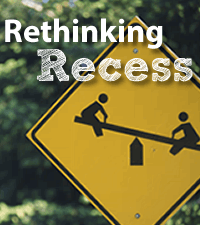Rethinking Recess
By Kecia Lipscomb Communicator April 2014, Volume 37, Issue 8 Recess is a great time for students to take in the sunshine and fresh air, and enjoy well-deserved free time. It also provides an opportunity for teachers and students to socialize and form positive relationships. A structured recess program can help accomplish that.
By Kecia Lipscomb
Communicator
April 2014, Volume 37, Issue 8
 Recess is a great time for students to take in the sunshine and fresh air, and enjoy well-deserved free time. It also provides an opportunity for teachers and students to socialize and form positive relationships. A structured recess program can help accomplish that.
Recess is a great time for students to take in the sunshine and fresh air, and enjoy well-deserved free time. It also provides an opportunity for teachers and students to socialize and form positive relationships. A structured recess program can help accomplish that.
In its traditional form, recess poses challenges, both for teachers managing it and students participating in it. Even though it is a time when students feel they are free to be themselves, run, play, and socialize, we still expect them to act in a reasonable manner. This is not always the case. Some teachers find it difficult to manage the insurmountable amount of energy of countless children at one time in a big space. Teachers must closely monitor for behaviors, as well as successfully transition students back to class.
This moderately supervised time increases the opportunity for students to be mean to one another, and bullying can be rampant. Further, recess can be an emotional challenge for many students, because children are still learning social etiquette and sportsmanship during games. Many students lack exposure to physical skill sets, which can lead to arguments regarding who is playing games the “right” way. Student injury on the playground and equipment is also a major safety concern.
Structured Fun
Structured physical activity is a positive way to combat these challenges during recess. Structured physical activity can include organized games (such as kickball or softball) with a teacher, rotations in time on the playground equipment, exercise laps, extended exploration lessons (in science, for instance), opportunities for reading outside, or traditional recess activities (such as tossing balls, jumping rope, running). All of these activities can be structured and organized within a typical 30-minute recess timeframe.
Why does structured recess work well? Research shows that students need validation: they need to know what to do and that they are doing it correctly. Thus, a structured physical activity process allows students to learn how to play cooperatively, respond appropriately to peers and teachers, play fairly, and transition smoothly between activities. With more supervision, teachers can minimize students’ opportunities for bullying or other negative behaviors.
Get the Ball Rolling
To initiate a structured recess program, a school’s administration needs to set expectations for the program and work with teachers to establish rituals and routines. Throughout the week, administrators should monitor the program to ensure its fidelity. Principals should:
- Set reasonable expectations for the program to ensure its quality.
- Be patient with staff members as they adjust their own expectations. Remind teachers that recess time, while traditionally unstructured, must have structure to ensure the development of the whole child.
- Stress that, though recess is a fun time, teachers are still responsible for fostering a positive learning environment. Therefore, administrators and teachers should work cooperatively to provide for quality physical activity that will ensure exercise, safety, learning, and fun.
- Hold a bimonthly dialogue on recess. There, staff can discuss the strengths and weaknesses of the program, and advance any next steps to enhance recess time.
Kecia Lipscomb is principal of Arthur Ashe Jr. Elementary School in Richmond, Virginia.
—
Copyright © 2014. National Association of Elementary School Principals. No part of the articles in NAESP magazines, newsletters, or website may be reproduced in any medium without the permission of the National Association of Elementary School Principals. For more information, view NAESP’s reprint policy


